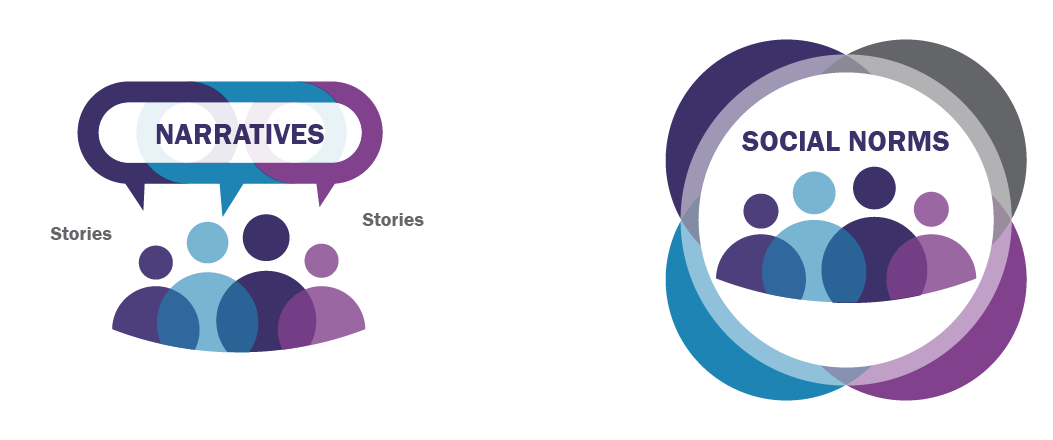
Social norms refer to values, beliefs, attitudes, and/or behaviors shared by a group of people. They are often based on what people believe to be normal, typical, or appropriate. Social norms can function as unspoken rules or guidelines for how people behave, and for how people are expected to behave. People generally follow social norms because they want to fit in with the people around them.
Social norms can result in positive or negative outcomes.
Sometimes social norms help people behave in ways that keep themselves - and others - safe and healthy.
Positive Example
A senior in high school is in her first serious relationship. She stopped spending time with friends and family and has been neglecting obligations like homework and piano practice. Her partner wants to be with her all the time, and demands to know where she is and who she is with when they aren't together. She likes the attention from her partner, but she doesn’t know if her partner’s behavior is normal or okay. She asks her friends about their relationships and learns that their boyfriends and girlfriends give them plenty of space to be independent. She decides to breakup with her partner before things get any more serious and unhealthy.
Other times, social norms can have the opposite effect, and can lead people to behave in harmful ways.
Negative Example
A man is playing with his daughter in a busy public playground. He notices a woman yelling at a young boy and violently shaking him by the shoulders. The man wants to stop her, but he looks around and sees that the other parents and caregivers are looking away from the woman, trying to 'mind their own business.' He doesn't want to do something that the others will disapprove of, so he does nothing.
Social Norms and Violence

 Social norms can affect nearly any aspect of our lives. They contribute to our clothing choices, how we speak, our music preferences, and our beliefs about certain social issues. They can also affect our attitudes, beliefs, and behaviors related to violence.
Social norms can affect nearly any aspect of our lives. They contribute to our clothing choices, how we speak, our music preferences, and our beliefs about certain social issues. They can also affect our attitudes, beliefs, and behaviors related to violence.
The way we react to violence may be based on what we see other people do, or how we think other people would act. In other words, our reactions are based on what we believe is normal or appropriate.
Misperceptions

 People often misperceive (or misunderstand) social norms and overestimate the number of people who behave in unhealthy ways or who accept unhealthy behavior. Researchers have studied college students' misperceptions of social norms related to alcohol use. They've found that most college students do not enjoy heavy drinking. However, they tend to think that heavy drinking is the norm among their peers and overdrink to fit in.
People often misperceive (or misunderstand) social norms and overestimate the number of people who behave in unhealthy ways or who accept unhealthy behavior. Researchers have studied college students' misperceptions of social norms related to alcohol use. They've found that most college students do not enjoy heavy drinking. However, they tend to think that heavy drinking is the norm among their peers and overdrink to fit in.
Misperceptions can be harmful when a person alters their own beliefs and behaviors based on a false assumption about other people's beliefs and behaviors.
Narratives vs. Social Norms
People sometimes confuse social norms with narratives. Narratives are stories that groups tell to understand how the world works, why problems occur, and who's responsible for solving them. This differs from social norms, which are often unspoken and shape what people believe to be "normal."

Using the Social Norms Approach to Prevent Violence
The social norms approach, when used in the field of public health, motivates individuals and groups to adopt social norms that result in positive health and wellbeing.
This can be done by:
- correcting misperceptions about social norms that lead to harmful attitudes, beliefs, and/or behaviors;
- changing or modifying negative or harmful social norms; and
- promoting positive social norms.
The social norms approach draws heavily on social marketing and health communications techniques. Some people refer to social norms work as social norms marketing. People and organizations create social norms campaigns to deliver messages designed to correct misperceptions, change social norms, or promote social norms.
When using a social norms approach, instead of telling people what to do, make sure to provide accurate information about attitudes, beliefs, and behaviors that will allow them to adopt new, healthier social norms.
To develop a social norms campaign, follow the steps below.

6 STEPS TO A SOCIAL NORMS CAMPAIGN
Check out CDCynergy Lite: Social Marketing Made Simple for information about best practice social marketing principles and developing, implementing, and evaluating an effective social marketing plan. Appendices with useful charts, forms, and questions to help guide users through the planning process are also included.
1. Describe the problem.
Clarify what problem you want to address, who the problem affects, and the root causes of the problem. A clear problem description will help you decide how best to address the problem and whether or not a social norms approach is appropriate. It will also help you identify and characterize the audience you wish to affect.
2. Collect data and identify social norms.
Collect information about your audience to better understand their attitudes, beliefs, and behaviors related to the problem you are addressing; this is sometimes called market research, formative research, or audience research. Identify social norms that exist among the audience and identify any misperceptions between actual norms and perceived norms (i.e. the differences between people's actual behavior and how they think other people behave). The information you collect during this step will provide baseline data and will help you identify strategies to reach your audience.
3. Develop a strategy.
Your strategy should clarify what you are aiming to achieve (e.g. change or promote a specific social norm and related attitudes, beliefs, and/or behaviors) and how this change will benefit your audience. Define your goals and objectives and describe how you will achieve your goals (e.g. distribute messages via social media). Your strategy should include your dissemination plan (a dissemination plan is how you will distribute messages and materials to your audience).
4. Develop and test messages and materials.
Once you have a clear strategy, it is time to develop messages and materials. Before disseminating your campaign, be sure to test the messages and materials you develop with audience members to ensure that they are acceptable, appealing, understandable, and useful.
5. Disseminate messages and materials.
Once your messages and materials are complete, distribute them through channels that will reach your audience (e.g., display posters around a school, share messages on Facebook, distribute a link to a website).
6. Monitor activities and evaluate outcomes.
Constant assessment of your campaign activities will allow you to see what is working so you can make adjustments as necessary. Once your campaign has ended, evaluate whether or not it had the desired effect on the audience.
Resources
Websites:
Guides:
Journal Articles:
- Effectiveness of Social Norms Media Marketing in Reducing Drinking and Driving: A Statewide Campaign.
- Youth Misperceptions of Peer Substance Use Norms: A Hidden Risk Factor in State and Community Prevention
- A Dangerous Boomerang: Injunctive Norms, Hostile Sexist Attitudes and Male-to-Female Sexual Aggression

